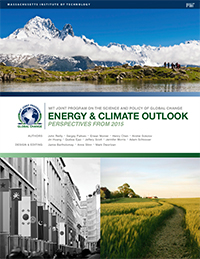
This December’s International climate negotiations in Paris are expected to yield reductions in manmade greenhouse gas emissions, but unless deeper cuts follow, the global temperature is likely to rise 3.1–5.2 degrees Celsius above pre-industrial levels by 2100, according to a report released on Monday by the MIT Joint Program on the Science and Policy of Global Change. The projected temperature increase far exceeds the 2°C threshold identified by the United Nations Framework Convention on Climate Change as necessary to avoid the most serious impacts of climate change, from rising sea levels to more severe precipitation patterns to increased wildfires.
New pledges from countries responsible for the largest global share of greenhouse gas emissions, announced in advance of the UN Climate Change Conference in Paris, promise to make barely a dent in the Earth’s warming trend, says MIT Joint Program Co-director John Reilly, a coauthor of the report, the 2015 Energy and Climate Outlook.
“Those pledges shave 0.2°C of warming if they’re maintained through 2100, compared with what we assessed would have been the case by extending existing measures [due to expire in 2020] based on earlier international agreements in Copenhagen and Cancun,” Reilly observes. “We are making progress, but if 2°C stabilization is our goal, it’s not nearly enough.”
To determine the likely global impacts of extending existing measures beyond 2020 and implementing current pledges (known as intended national determined contributions, or INDCs) from the biggest emitters through the end of the century, Outlook researchers used the Joint Program’s Integrated Global Systems Model (IGSM), a linked set of computer models designed to simulate the global environmental changes that arise as a result of human causes. They also used the latest UN estimates of the world’s population, which is expected to reach 10.8 billion by 2100.
The report highlights several key findings in the areas of global climate, emissions and energy mix.
By 2100, the Outlook projects—relative to pre-industrial levels—increases in global mean surface temperature (3.1–5.2°C), global mean precipitation (7.1–11.4%), sea level (0.30 to 0.48 meters) and ocean acidity. Over the same period, greenhouse gas (GHG) emissions levels are expected to decline in developed countries but rise in some G20 nations and most developing countries, which should account for about 15% of global emissions by 2050.
“As a result of China and some of the other middle-income emerging countries taking on actions, we see emissions stabilizing in developed and many G20 countries,” says Reilly. “The looming issue is what happens in the rest of the world, which includes many of the poorer countries. Their emissions remain a relatively small share of global emissions, but continue to grow. A challenge is how those countries achieve sustainable growth that doesn’t lead to ever greater GHG emissions.”
The Outlook also projects that carbon dioxide emissions from fossil fuels (about 50% generated by the electricity and transportation sectors) will remain the largest source of GHGs, accounting for about 67% of total GHG emissions by 2100. Despite rapid growth in renewables and nuclear energy, fossil fuels will continue to account for about 75% of the global energy mix in 2050.
“In this Outlook we tried to represent the mix of policies and measures that countries will pursue to meet the INDCs they’ve laid out,” says Reilly, noting that most of these favor targets for wind and solar generation, vehicle fuel economy standards and phasing out coal from the power sector. “That leads to a different mix of energy technologies than if we had a broad carbon pricing scenario in these countries.”
According to the Outlook’s projections, by 2030, the planet will be within about 5 years of reaching a cumulative emissions level deemed by the Intergovernmental Panel on Climate Change as consistent with a 50% chance of exceeding the 2°C threshold (which it would likely pass by the 2050s). But based on significant recent progress in international climate negotiations resulting in major improvements in GHG emissions levels, the report’s authors remain optimistic that world leaders will follow the Paris talks with more ambitious climate policies.
“The extension of the forecast beyond 2025 or 2030 is not a prediction of what is most likely,” they write. “Rather it is intended to indicate the need for continued effort, and a measure of the magnitude of effort needed.

